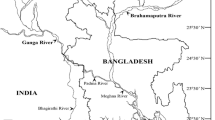Abstract.
Pigment contents, proteins and net photosynthesis were investigated in fully developed leaf of 1-year-old seedlings of six mangroves (Bruguiera gymnorrhiza, Rhizophora apiculata) and mangrove associates (Caesalpinia bonduc, Cerbera manghas, Derris heterophylla, Thespesia populnea), collected from Bhitarkanika, located on the east coast of India. Large variations in the photosynthetic rates (P N) among the six species were observed, ranging from 10.16 µmol CO2 m–2 s–1 in C. bonduc to 15.28 µmol CO2 m–2 s–1 in R. apiculata. The total leaf protein content ranged from 12.09 mg g–1 dry wt in T. populnea to 51.89 mg g–1 dry wt in B. gymnorrhiza. The chlorophyll a/b ratio was typically about 3.0 in all the studied species, except C. bonduc (2.8). Photosynthetic rates and chl a/b ratio in the leaves were found to be correlated. Analysis of chlorophyll and xanthophyll spectra suggested: (1) variations in different forms and amounts of carotenes as well as xanthophylls and (2) the presence of high amounts of near-UV-absorbing substances in leaves, particularly in the two mangroves (B. gymnorrhiza, R. apiculata) and a mangrove associate (T. populnea), which appears to be an adaptive feature. Estimation of the chl a/b ratios in isolated thylakoids yielded a low value of 1.8 for R. apiculata and >2.6 for other species. The total protein/chlorophyll ratios in thylakoids varied considerably from 3.14 (D. heterophylla) to 10.88 (T. populnea) among the mangrove associates and from 16.09 to 18.88 between the members of the Rhizophoraceae. The chlorophyll/carotenoid ratios in thylakoids of the six species were more or less similar. The absorption spectra for washed thylakoids of C. manghas and D. heterophylla exhibited absorption characteristics typical for C3-plant thylakoids. However, thylakoids isolated from R. apiculata, B. gymnorrhiza, C. bonduc and T. populnea exhibited an unusual increase in absorption in the blue region (380–410 nm) of the absorption spectrum. The presence of high-absorbing (in the short-wavelength, near-UV region) pigments appears to be closely associated with the thylakoids in R. apiculata and T. populnea. Our results, therefore, suggest a wide range of variation, not only in protein and pigment contents of photosynthetic tissues, but also in the spectral characteristics and composition of the pigments in mangrove species. An understanding of the nature of these pigments in mangroves and their associates, under their natural conditions and especially in relation to eco-physiological adaptations, is necessary, not only in relation to conservation, but also to allow propagation under different salinity conditions.
Similar content being viewed by others
Author information
Authors and Affiliations
Additional information
Electronic Publication
Rights and permissions
About this article
Cite this article
Das, .A., Parida, .A., Basak, .U. et al. Studies on pigments, proteins and photosynthetic rates in some mangroves and mangrove associates from Bhitarkanika, Orissa. Marine Biology 141, 415–422 (2002). https://doi.org/10.1007/s00227-002-0847-0
Received:
Accepted:
Issue Date:
DOI: https://doi.org/10.1007/s00227-002-0847-0




